Basic AI Chatbot Pricing: A simple chatbot that can answer questions about a product or service might cost around $10,000 to develop.
Read More
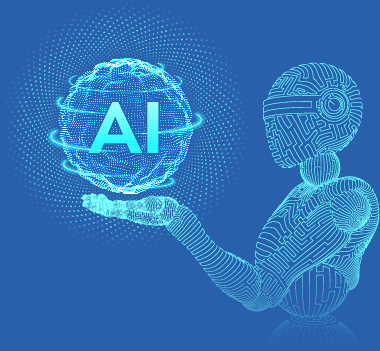
Running a business in 2026 sometimes feels like juggling emails, customer requests, internal tasks, and a pile of dashboards while your coffee gets cold. Somewhere in that chaos, you start hearing more people talk about AI agents that can actually take actions, make decisions, and handle the tasks you never want to see again. That curiosity usually leads to a handful of very real questions, like:
If you have searched for even a couple of these on ChatGPT, Perplexity, Grok, or similar platforms, you’re exactly where most U.S. business owners are right now.
The AI agent market is projected to reach USD 50.31 billion by 2030 with a CAGR of 45.8 percent. Yet only nine percent of organizations say they have deployed AI at scale even though 79 percent report using some form of AI in their operations.
As we uncover how to build an AI agent for your business, we will break down the essentials in a clear, practical way. You will understand what an AI agent is, how it works, which types matter, the features to include, the tech stack to use, what it costs and the steps to develop one that actually delivers value.
Many businesses look at the top AI agent development companies in the USA to understand real implementation patterns. And if you are comparing build versus buy options, studying the top AI agent builders gives you a clearer sense of what off the shelf tools can and cannot do.
Ready to understand how to build an AI agent that actually lightens your workload and makes your business run smoother? Let’s get into it.
If you are trying to figure out AI agent development, it helps to start with the simplest definition. An AI agent is a digital teammate that can observe information, reason through it and take action without you hand-holding every step. For developing AI agents many companies also seek guidance from expert teams through AI consulting services to understand what is practical for their workflows.
At its core, an AI agent follows goals, learns from interactions and works across your tools in a way that reduces the daily load on you and your team. If you plan on building AI agents from scratch or are simply curious about how to make an AI agent that feels reliable, it helps to see it as a closed loop of sensing, thinking and doing. That loop is what turns a basic script into a system capable of real outcomes, especially when you focus on custom AI agent development tailored to your processes.
Here is a quick way to think about what an agent really is when you start creating an AI agent for your business:
This is the foundation of how to build your own AI agent in a way that supports your business instead of adding another tool to manage.
Building an AI agent can feel mysterious at first, but the way it works is actually pretty logical. Once you understand the core mechanics, you can decide how to make an ai agent that fits your business goals.
Your agent starts by analyzing user intent, system triggers or data signals. This is where language models, prompts and context rules shape how well it grasps meaning. When you bold create an AI agent, this layer decides how accurate and useful its responses are.
Next, the agent interprets the situation and decides what to do. It may access tools, query databases or apply rules to complete an action. If your team already uses automation workflows, you can extend them with agent logic or tap into streamlined AI integration services to strengthen how your system thinks.
Once it picks a direction, the agent executes tasks like sending updates, pulling records, summarizing information, or completing multi-step workflows. Teams building bold custom AI agent development models often combine internal APIs with structured task libraries for smooth execution.
A strong agent improves with time. Logs, feedback loops and model tweaks help it refine decisions. When building bold developing AI agents, many companies pair this phase with model tuning or even dedicated AI model development processes.
| Component | What It Does | Why It Matters |
|---|---|---|
|
Input Layer |
Understands user queries and system signals |
Shapes accuracy and context handling |
|
Reasoning Engine |
Decides next best action |
Determines intelligence and reliability |
|
Action Module |
Executes tasks and workflows |
Powers real business outcomes |
|
Learning Loop |
Improves from feedback |
Keeps the agent getting smarter over time |
As you move ahead, these mechanics will help you choose which bold creating an AI agent approach fits your business and what type of agent you should build next. Let’s explore the different types so you can zero in on the one that actually matches your use case.
Get expert guidance on choosing the right architecture and building your first working prototype.
Start My AI Agent Build Plan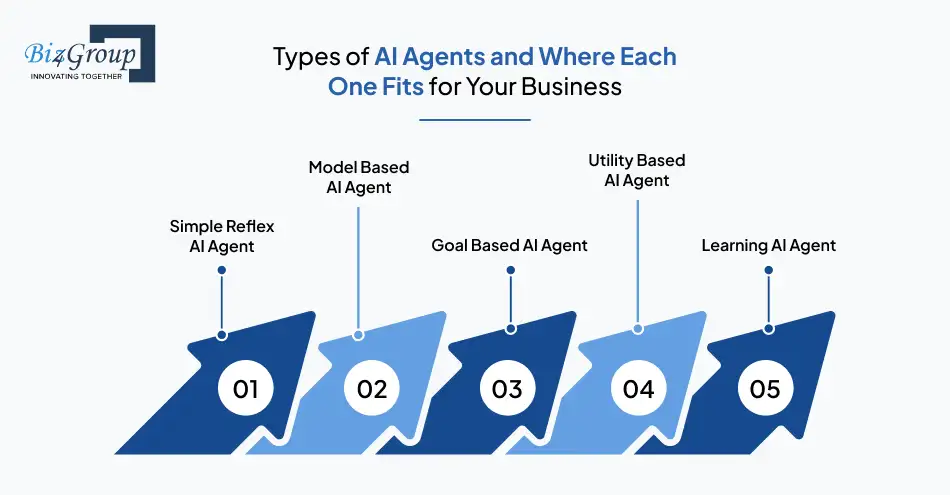
Building the right kind of AI agent starts with knowing what category actually aligns with the workflow you want to automate. Once you understand these types, you’ll have a clearer idea of what architecture you should use when you build an AI agent that fits your business:
| AI Agent Type | What It Means |
|---|---|
|
Simple Reflex AI Agent |
Acts only on the current input with no memory. Good for very basic rules when creating an AI agent. |
|
Model Based AI Agent |
Uses an internal model to understand the environment. Useful when you are building AI agents from scratch that need context. |
|
Goal Based AI Agent |
Chooses actions based on specific goals. A practical fit when you create an AI agent that must plan. |
|
Utility Based AI Agent |
Evaluates which action gives the best outcome. Helpful for custom AI agent development where decisions impact revenue. |
|
Learning AI Agent |
Learns and improves over time, ideal if you want to know how to build your own AI agent that evolves with data. |
Choosing the right type early helps avoid over-engineering and also clarifies what tools you may need, such as light planning modules or deeper AI integration services like those mentioned in Biz4Group’s guide on AI agent implementation. With the types clear, we can now shift into why it actually makes sense for businesses to invest time and resources into this.
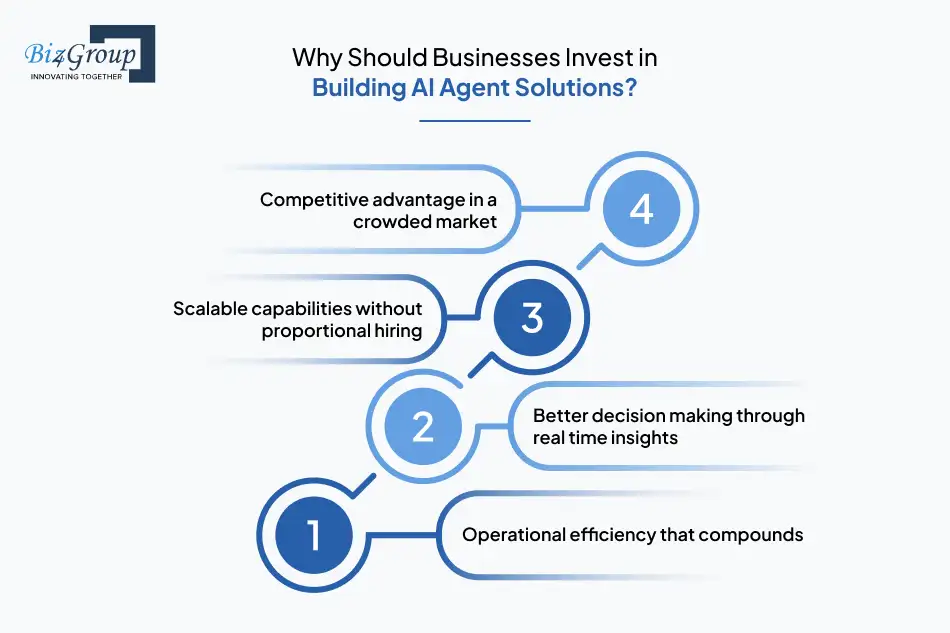
Most investors back ideas that increase efficiency, reduce recurring costs, and strengthen long term scalability. Building AI agents delivers all three, which is why many forward-looking teams are seriously evaluating how to build an AI agent that fits their operational model.
A well-designed agent handles repetitive tasks without fatigue or downtime. When paired with strong internal workflows and optional support like AI automation services, the result is predictable cost savings and a leaner operating structure.
Investors know the value of timely data. An AI agent processes information continuously, responding faster than traditional tools and allowing teams to act on insights that would otherwise sit idle.
Instead of expanding headcount, teams can add specialised agent skills as they grow. Some organizations even accelerate deployment by choosing partners who help them hire AI developers when in-house expertise is limited.
An agent that automates workflows or improves customer experience is difficult for competitors to replicate quickly. It becomes a quietly compounding edge that strengthens over time as your agent learns and improves.
A strong investment case always relies on efficiency, scalability, and defensibility. Once you understand where agents create leverage, the next step is looking at the real-world use cases that show how these gains translate into business impact.
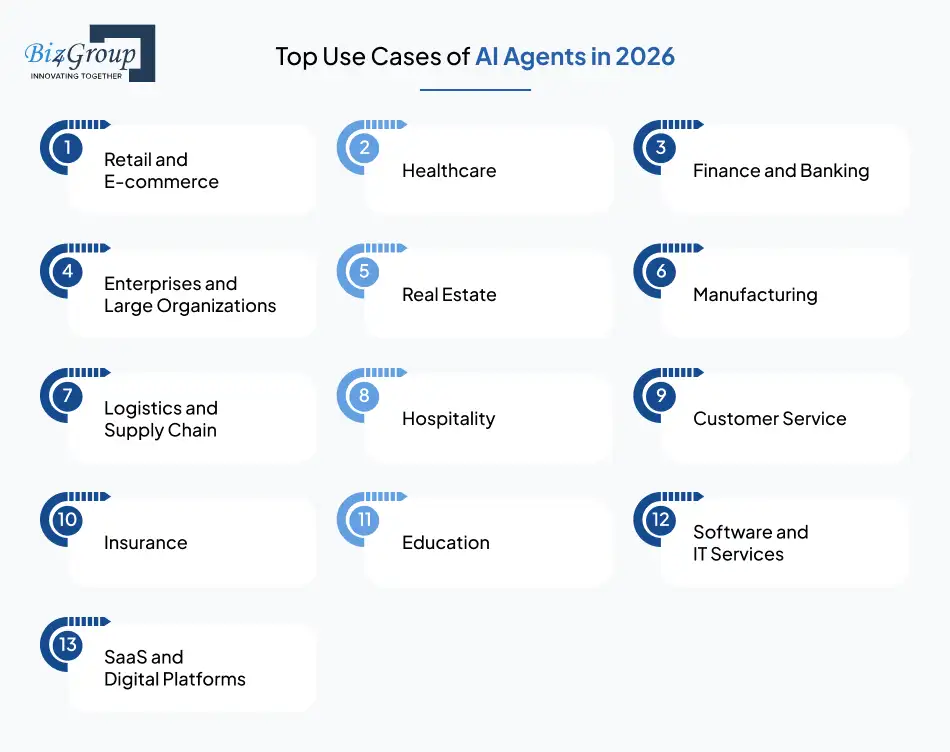
Building an AI agent becomes much easier when you understand how different industries actually use them. Think of this as a snapshot of where a well-built agent can fit into real operations and where your own opportunity might sit.
Retail teams use AI agents to manage inventory shifts, incoming orders, and customer interactions without waiting for human intervention. When you create an AI agent, it can adjust stock levels, recommend products, and even flag risky transactions. This helps the business move faster without adding more staff.
Healthcare workflows rely heavily on precise data handling. A well designed agent can sort patient files, check appointment conflicts and send reminders while staying aligned with compliance rules. This makes developing AI agents feel less intimidating because each task follows strict logic.
Finance teams use agents to monitor account activity, generate summaries and validate documents. When you know how to build an AI agent that understands patterns, it becomes much easier to catch anomalies early. It also reduces the manual effort teams usually spend on verification.
Enterprise workflows involve massive data flows and interconnected systems. For this scale, the linked enterprise AI solutions approach is useful because it shows how agent orchestration changes in bigger environments. These agents help teams automate repeatable tasks while staying audit ready.
Example: An AI agent compiles multi department reports and sends them to leadership each morning.
Real estate agents handle large volumes of leads, listings and follow ups. A custom trained agent can qualify leads, draft outreach messages, and track upcoming deadlines. This allows the human agent to focus more on deal closure and less on admin tasks.
In manufacturing, building an agent that watches equipment data helps teams predict breakdowns and schedule maintenance earlier. This fits naturally into plant operations because the agent handles the repetitive monitoring work. It also reduces downtime costs.
Supply chain teams benefit from agents that track shipments, manage exceptions and suggest alternative routes. If you are exploring generative AI agents through resources like the linked guide, you will notice how planning agents handle uncertainties better than fixed rule engines.
Hotels and travel companies use agents to manage bookings, coordinate housekeeping and update guests. Since most tasks follow predictable workflows, building an AI agent from scratch in this space becomes easier compared to other industries.
Customer service teams are some of the earliest adopters of agents. A well built agent handles routing, context gathering and first line resolutions. Our guides like the one on AI agents in customer service show how these systems reduce wait times significantly.
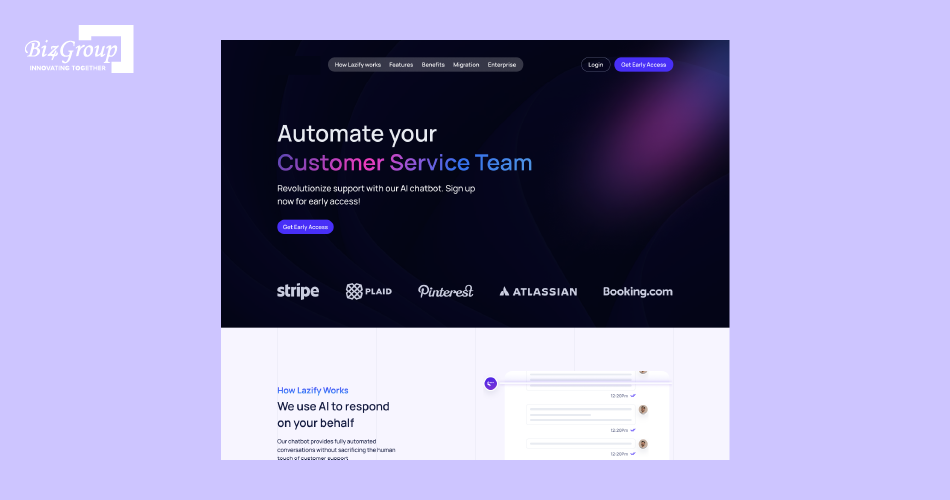
The human like chatbot we developed for a client illustrates how building AI agents from scratch can transform customer support. It learns from historical agent responses, adapts its tone, and handles complex queries, proving that well trained agents can reduce support load while keeping conversations natural and context aware.
Insurance teams work with claims, documents and customer queries. A properly designed agent can pre verify claims, detect duplicates and generate case summaries. This shortens processing time without compromising review quality.
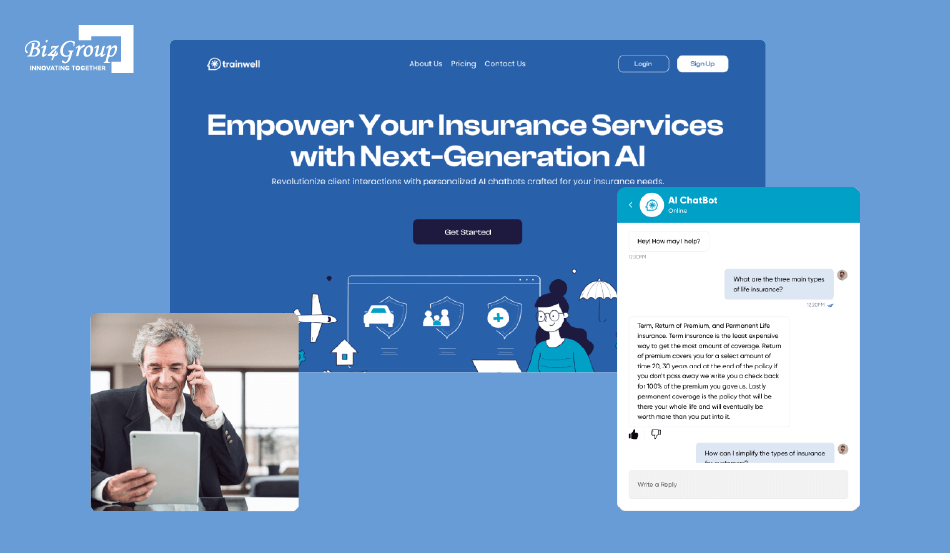
Insurance AI shows how to build your own AI agent for real time knowledge retrieval and internal training. By combining custom LLMs, feedback driven learning, and simple integration, it helps insurance teams access accurate information instantly without requiring repeated live training sessions.
Schools and learning platforms rely on structured data and recurring tasks. When you know how to create an AI agent for this domain, it can track student progress, plan content and send nudges where needed. This helps educators spend more time teaching.
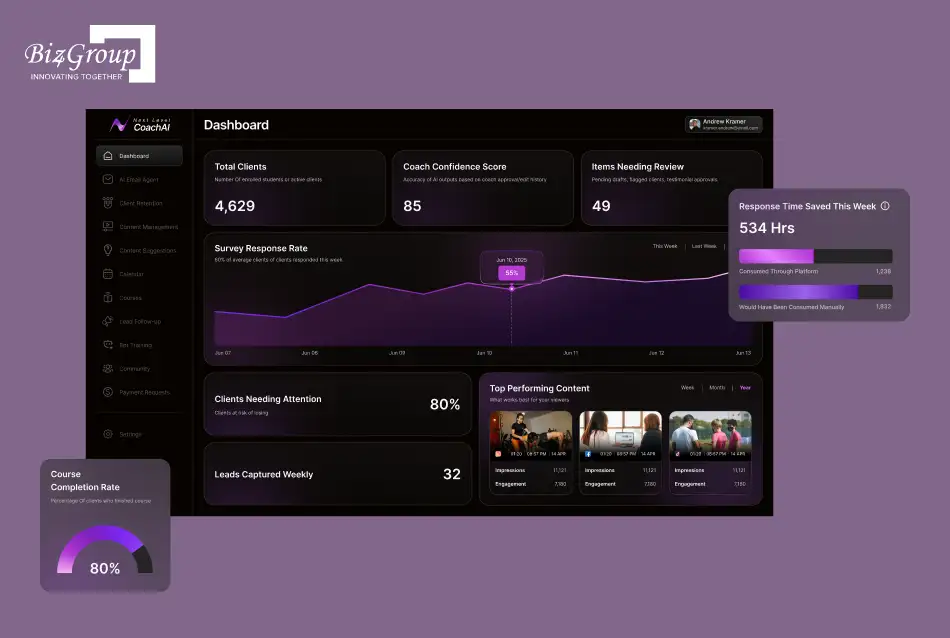
Coach AI is a great example of how to build an AI agent that manages communication, tracks client sentiment, and automates daily admin work for coaches and educators. With email management, retention insights, and a replica bot, it shows how agents can scale personalized engagement without adding operational load.
Technical teams use agents to analyze logs, manage deployments and flag system outages. This makes creating an AI agent for IT quite practical because most data sources are already structured.
SaaS companies rely on agents to onboard users, answer product questions and surface insights from user interactions. If you explore how to integrate AI into an app, you will notice that many SaaS tools use modular agentic components behind the scenes.
When you understand how different industries apply agentic systems, it becomes much easier to picture how to build an AI agent for your own operations. Next, we will look at the features your agent truly needs so it performs well from day one.
Before adding fancy upgrades, your focus should be on essentials that make your AI agent reliable, safe, adaptable, and capable of improving with real-world usage. These are the baseline building blocks, not optional add-ons, and they set the stage for everything you build next:
| Core Feature | Why It Matters When Building an AI Agent |
|---|---|
|
Natural language understanding |
Helps the agent understand real human queries without confusion. |
|
Context memory and recall |
Allows continuity, so it remembers previous inputs and conversations. |
|
Multi data source ingestion |
Accepts knowledge from APIs, docs, CRM, and private repositories. |
|
Reasoning and decision logic |
Prevents guess-based responses and supports rational outcomes. |
|
Role and policy based access |
Controls who can view, update, or manage data and actions. |
|
Secure encryption and compliance |
Protects sensitive data across internal and external systems. |
|
Feedback driven learning loop |
Improves the agent using real corrections instead of static rules. |
|
Error handling and fallback responses |
Avoids dead-ends and supports helpful redirection. |
|
Model upgrade flexibility |
Lets you adapt from one model to another like Llama or GPT without rebuilding everything. |
A strong foundation also depends on whether you plan to build AI agent with ChatGPT or go with a more controlled path like custom LLM adaptation through expert led generative AI agents. Either way, these core features make your system feel dependable before you experiment with advanced capabilities like tools, agents collaborating, or real-time automation.
Next, let’s explore advanced features that turn a basic agent into a highly capable one.
Validate feasibility, performance expectations, and data requirements before you commit.
Request My AI Feasibility CheckOnce you validate your base functionality, the next step is to level up capabilities, so your AI agent feels smarter, faster, and more independent. Below are the high-value add-ons that make a real difference in enterprise-grade systems.
Let your AI agent shift tone, role, and domain knowledge based on user context or task demands. It prevents robotic, repetitive replies, and feels more human awareness.
Moving from responding to thinking, using reasoning and layered decision logic rather than template outputs. Leveraging platforms that enable generative AI can unlock richer responses and problem solving.
Build your AI agent to operate across chat, web widgets, workforce platforms, tickets, and voice via cross-platform development. Interaction consistency matters more than platform identity.
Some use cases demand visual comprehension, rapid annotation, or inspection abilities. You can explore visual-first implementations through solutions like build visual AI agent to expand use cases beyond text workflows.
Your AI agent should perform end-to-end tasks like updating records, creating requests, generating documents, or triggering actions without supervision while logging reasoning for transparency.
When you combine foundational features with the right advanced capabilities, your roadmap for how to build an AI agent starts looking more like a long-term digital workforce plan instead of a one-time project.
Now let’s break down the step-by-step development flow so you know what happens in what order.
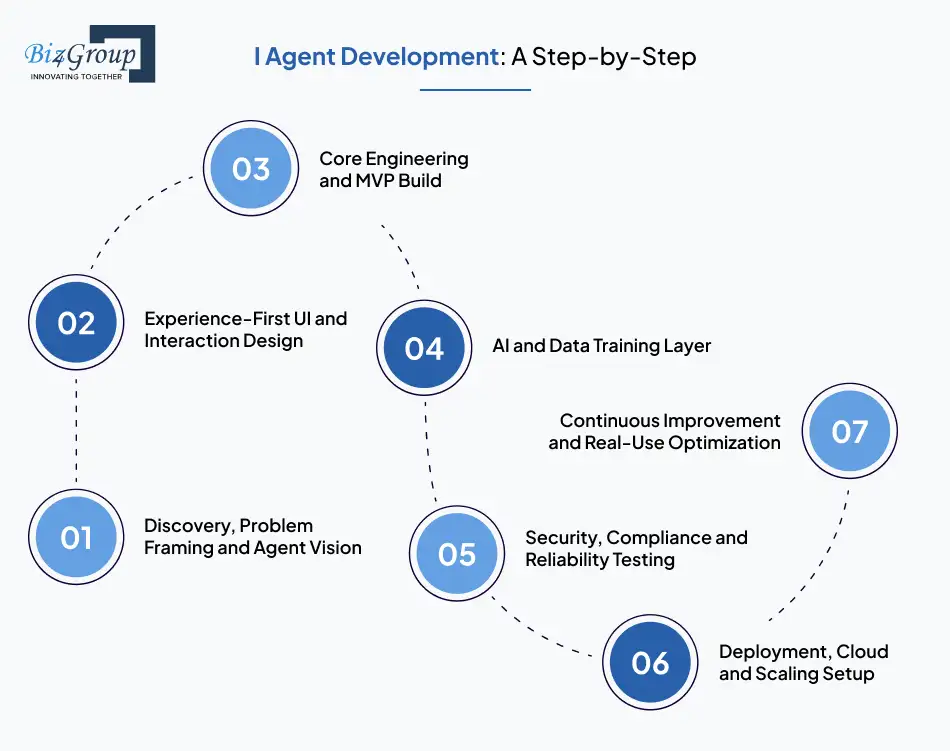
Building an AI agent is not about rushing into development or wiring an LLM to your product overnight. The goal is to build something that thinks, acts, and improves, just like a reliable team member. Here’s the practical roadmap most founders and product leaders follow for AI Agent Development for business.
Start by identifying what role your AI agent will replace, support or upgrade inside your business. Are you aiming for a decision-making agent, a task-execution agent, a sales assistant, or an internal operations agent? Clarity here avoids expensive rework.
Define measurable outcomes like reduced workload hours or increased turnaround speed
Even the smartest AI agent fails if people hate interacting with it. Design the interface, workflow, and conversational experience so it feels helpful rather than robotic or overwhelming. This applies whether you are building a voice-first, chat-first or dashboard-first agent. You can also collaborate with a specialist UI/UX design company when you need deeper product experience strategy.
Also read: Top UI/UX design companies in USA
Avoid building a massive AI system straight away. Instead, release a controlled version with only the minimum agent-intelligence required to prove value via MVP development services. Your MVP should include the agent’s core reasoning engine, decision triggers and tool/action integrations so stakeholders can validate usefulness early.
Also Read: Top 12+ MVP Development Companies in USA
Your agent becomes intelligent only when it has access to the right structured and unstructured data. This includes business knowledge, tools, process rules, user intent examples, historical queries, and outcome mapping. Combine domain-specific training with smart prompting and customized memory logic.
Every AI agent handles information that may be private, sensitive or business-critical. Perform stress tests, adversarial prompt testing, hallucination checks, fail-safe responses and access controls before launching.
Also Read: Software Testing Companies in USA
Once stable, deploy your AI agent with clear rules on updates, monitoring, uptime, and error reporting. Ensure scalable cloud architecture, secure API integrations and fallback modes for anomalies.
A great AI agent never ships and stops, it ships and learns. Post-launch refinements are where agent intelligence compounds over time.
With this full development flow in place, the next puzzle is choosing the right tech stack so your AI agent stays scalable, cost-efficient and expandable over time. Ready to break it down?
Choosing the right tech stack keeps your agent fast, scalable, secure, and ready for future upgrades. Here’s a smart, business-friendly breakdown:
| Label | Preferred Technologies | Why It Matters |
|---|---|---|
|
Frontend Framework |
ReactJS, Vue.js |
Modern technologies like ReactJS development help you build fast, intuitive and scalable screens that users actually enjoy interacting with. |
|
Server-Side Rendering & SEO |
NextJS, Nuxt.js |
Using a framework like NextJS development improves SEO, speed, and shareability which helps if the agent has a public or semi-public interface. |
|
Backend Framework |
NodeJS, Python |
Async operations using NodeJS development for workflows, while Python development enables advanced model logic and integrations. |
|
AI & Data Processing |
Python, LangChain |
Since Python remains dominant in AI, using a partner experienced in Python-based AI engineering ensures your agent can evolve and adapt through real usage. |
|
API Development & Middleware |
Express.js, FastAPI |
You will require clean, secure, event-ready APIs to connect agent actions with tools, CRMs or workflows without bottlenecks. |
|
Database & Vector Storage |
PostgreSQL, Pinecone, MongoDB |
Works well for long-term memory, embeddings, and conversation intelligence that your agent depends on to stay accurate. |
|
Cloud & Deployment |
AWS, GCP, Azure |
These platforms provide scaling, logging, role-based access and monitoring that strong enterprise agents require to perform reliably. |
|
Security & Compliance |
JWT, OAuth2, Vault, SSO |
Must protect data, identity and access because AI agents interact with sensitive company information. |
The right tech stack is not just about what is popular, but about what helps your AI agent think, remember and act without breaking under real production pressure. Next, we will move into cost planning so you know what it takes to build responsibly instead of guessing blindly.
Avoid costly rebuilds by selecting the right technologies from day one.
Help Me Choose The Best Stack for AI Agent DevelopmentThe cost to build an AI agent typically ranges between $30,000 and $200,000 plus, depending on scope, complexity, integrations, security needs, training data, and scaling plans. This is a ballpark estimation, not a fixed quote, because every custom AI agent development project has different goals and technical depth:
| Project Scale | Estimated Cost Range | What You Typically Get | Who It Suits |
|---|---|---|---|
|
MVP AI Agent |
30,000 to 60,000 USD |
Basic workflow automation, essential UI, foundational AI model integration, limited data sources, and usage monitoring. Great starting point if you first want to validate value using something like an AI agent proof of concept. |
Startups, early adopters, founders testing demand |
|
Mid-Level AI Agent |
60,000 to 120,000 USD |
Advanced reasoning, third-party integrations, analytics dashboard, authentication, fail-safes, and tailored user journeys. Ideal for teams planning to scale across internal or customer-facing channels. |
SMEs and scaling digital businesses |
|
Enterprise AI Agent |
120,000 to 200,000 plus USD |
Compliance ready build, multi-environment deployment, multi-persona logic, custom training pipelines, and integration into enterprise ecosystems achieved via custom software development companies. |
Large enterprises, regulated industries, global brands |
While building an AI agent sounds like a one-time project, it behaves more like a product ecosystem involving continuous learning, iteration, and real-world adaptation. You will get a much clearer and risk-free estimate once your use case, data readiness, and automation depth are defined.
Next, let’s explore how to monetize your AI agent so the investment compounds instead of just balancing costs.
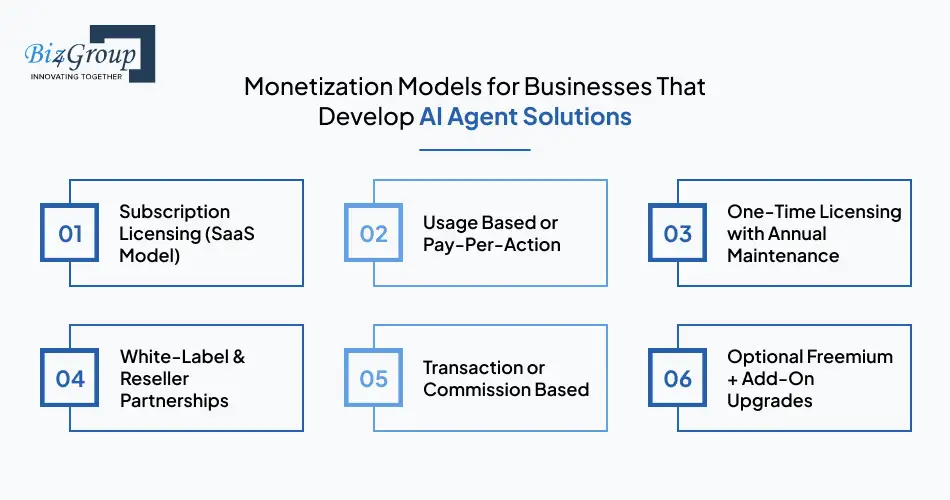
Once you decide for AI agent development, you should also define how it will generate predictable and scalable revenue. Below are business-friendly monetization formats you can apply whether you’re creating an AI agent for internal use or commercial resale.
This works best if you want recurring revenue and ongoing user relationships. You provide access based on monthly or annual pricing tiers, offering more value to higher plans such as workflow automation, deeper integrations, or faster processing. This is a strong fit when developing AI agents that continuously learn and improve.
Ideal when users may not want fixed commitments and prefer paying for what they consume. This is effective for conversational AI agent development where actions like API calls, tasks executed, or data requests can be metered and billed transparently. Great for B2B workflows and enterprise scenarios.
This applies enterprise AI agent development for large organizations who prefer full control and on-prem deployment. It includes a single major purchase cost followed by yearly support, updates, and compliance coverage.
This model turns your AI agent solution into a revenue multiplier. Other agencies, SaaS providers, or consultants sell your agent under their branding while you earn share-based commissions or partner pricing.
Best for marketplaces, service-driven products, or gig-based implementations. Instead of charging for the agent itself, you take a cut of actions the agent enables.
Here you let users try basic capabilities like simple prompts, limited transactions, or restricted integrations. When they want more depth in building an AI agent, they upgrade into automation modules, dashboard analytics, or multi-tool orchestration. Works great for fast adoption and product-led growth.
Define your revenue model early because it influences architecture, data flow, pricing UI, and scaling decisions before you move into best-practice implementation.
Save time, reduce trial and error, and build confidently with expert-driven planning.
Book My AI Strategy Session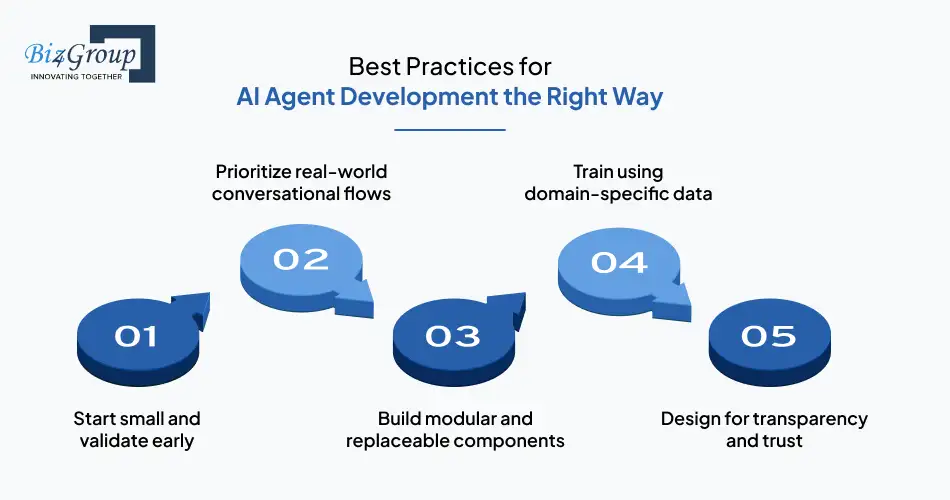
Building an AI agent is not just about coding features; it is about designing something that truly works inside a real business workflow. Here are practical rules that can help you build an AI agent that feels reliable, scalable, and genuinely useful.
Instead of trying to create an AI agent that solves everything at once, launch a focused version with one solid capability and gather real usage feedback before scaling. This mindset allows rapid iterations for AI conversation apps and reduces expensive rework.
Users judge your agent based on how accurate, natural, and contextual its replies are, so treat dialogue design like product design. You can use conversational references such as this conversational AI agent guide to ensure your flows mimic realistic human interactions.
As models, APIs, and frameworks evolve, designing a modular architecture helps you avoid full rebuilds later. This is a key principle of business app development using AI, where adaptability determines long-term survival.
Generic training makes generic output, so feed your agent the same terminology, documents, and tasks your team uses daily. Add regular retraining schedules so your agent grows instead of getting outdated.
Users should easily understand what data is used, how decisions are made, and what the agent can or cannot do. Clarity builds comfort, and comfort improves adoption, especially when scaling custom AI agent development inside enterprises.
To keep your how to build an AI agent journey smooth, think of best practices as the quality guardrails that help you scale with confidence, before we move deeper into challenges and future readiness.
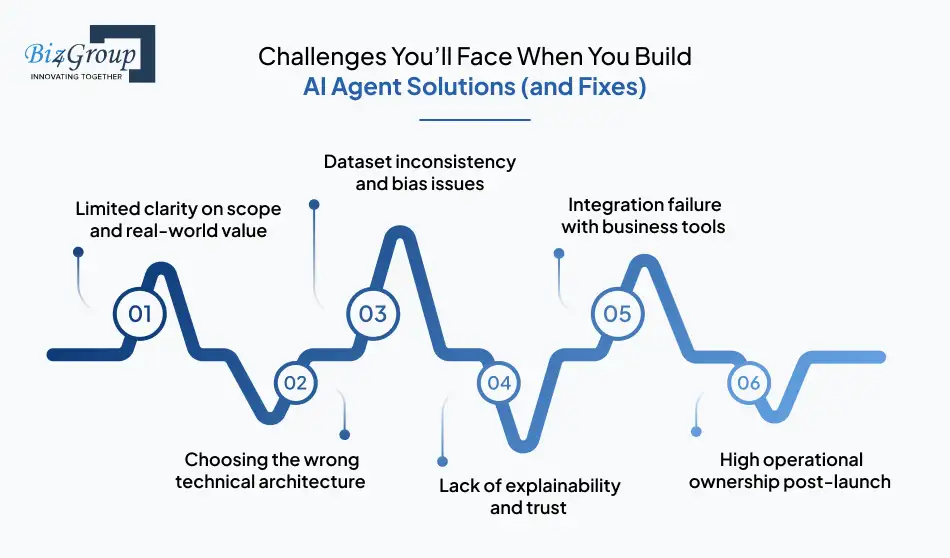
Even with a solid plan, there are practical and technical hurdles that can slow down the process of building an AI agent, so knowing them upfront gives you an unfair advantage before development begins. Her’s a quick look at how you can deal with such challenges:
| Top Challenges | How to Solve Them |
|---|---|
|
Limited clarity on scope and real-world value |
Begin with a well-defined use case, measurable success metrics, and compare benchmarks from industry leaders like the top AI development companies in Florida. |
|
Choosing the wrong technical architecture |
Start small, use modular development, and validate performance early instead of locking into rigid solutions that limit upgrades and scaling. |
|
Dataset inconsistency and bias issues |
Use diverse training data, continuous validation cycles, and human feedback loops so your developing AI agents improve instead of drift. |
|
Lack of explainability and trust |
Add transparent decision logs, test prompt chains, show reasoning where possible, and structure outputs for compliance-friendly auditing. |
|
Integration failure with business tools |
Prioritize API readiness, standard communication protocols, and the right engineering partner such as a seasoned software development company in Florida. |
|
High operational ownership post-launch |
Build monitoring dashboards, retraining guidelines, update cycles, and internal skill handover plans before deployment. |
A clear understanding of these blockers makes building an AI agent more predictable, scalable, and budget-aligned, setting you up smoothly for the next phase of your journey.
Real deployment experience, not theory, from enterprise to startup scale.
Discuss My AI Agent RequirementsThe pace of innovation makes it clear that now is the right moment to build an AI agent that can evolve with market needs. The next phase is not just automation but autonomous digital decision making.
Instead of offering generic responses, agents will understand tone, intent, sentiment, user history, and behavioral cues, leading to more human like outcomes. Industries like healthcare and finance will benefit most from this shift.
Your users will expect actions to happen across platforms, so interoperability will be key. Planning early API readiness through an AI chatbot development company is a strategic advantage.
Agents will not just respond to queries, they will complete multi step tasks across systems without supervision. This will redefine how businesses handle sales, support, logistics, claims, and training cycles.
Future adoption will lean toward industry trained and role trained agents that outperform broad AI assistants. Anyone planning to create an AI agent should consider deep domain training over generic prompts.
Businesses that continuously retrain, refine, and realign agents with emerging standards will lead long term. Staying updated with proven research is easier through curated insights through our blog on top AI agent trends.
The future belongs to businesses that start small, iterate fast, and scale with measurable value, so your next move is not whether to build an AI agent but how quickly and strategically you can bring it to life.
If you are serious about how to build an AI agent that is scalable, compliant, secure, and business-ready rather than just experimental, Biz4Group checks every box that matters. We combine real-world delivery experience, strong engineering maturity, and deep product thinking to help you create AI agents that are practical, personalized, and revenue-focused.
We have already built enterprise-grade systems, including a fully secure custom enterprise AI agent built with HIPAA and GDPR compliance. This puts us ahead of teams who are still working with surface-level chatbot prototypes or hobby-grade LLM wrappers.
Biz4Group is a dedicated AI agent development company that understands agent architecture, orchestration logic, safety layers, model strategy, and integration pathways for CRM, ERP, HRIS, POS, and analytics platforms.
Our approach is simple: build what creates measurable impact, not what sounds fancy in a pitch deck. We evaluate feasibility, cost, speed, risks, and immediate ROI so that you launch fast and scale confidently without burning time or budget.
If you want a partner who blends strategic clarity with hands-on execution, Biz4Group is built for that kind of collaboration.
From idea to deployment, get end-to-end help tailored to your business goal.
Get My Custom AI Build RoadmapSo, if you’re considering to build an AI agent, or somewhere between curiosity and action, and you’re wondering whether it’s worth the leap. Short answer: yes. Slightly longer answer: yes, but smartly planned, well-architected, and not using a random weekend hackathon prototype that falls apart when three users log in at once.
This is your chance to create an AI agent that becomes a long-term digital teammate, not a fancy toy. And if you ever feel stuck choosing features, stack, cost plan, monetization route, or roadmap, our guide on build AI software will help you dig deeper into execution fundamentals. Also, if you want a team that understands engineering, business viability, compliance, UX psychology, and commercialization, explore partnering with a reliable AI development company. Your future AI agent is already waiting for instructions.
Ready to explore a real AI agent build and not just theory?
Book a quick 20-minute discovery call and let’s validate your idea, feasibility, timeline, and budget before you spend a single dollar.
Not necessarily. You can build simple rule-based or pre-trained AI agents using no-code platforms, but for scalable, secure, and enterprise-grade use cases, custom engineering and API-level development becomes mandatory.
A realistic custom development budget falls between USD 30,000 to USD 200,000 plus, depending on complexity, integrations, model training, security, data pipelines, and scalability goals. Enterprise-grade builds may exceed this range if advanced autonomy is required.
A basic MVP can take 6 to 10 weeks, while mid-level or enterprise AI agents involving private data processing, workflows, and adaptive learning may require 3 to 6 months, including testing and optimization cycles.
You’ll need clean, structured data such as documents, FAQs, business workflows, customer interactions, and operational rules. The better and more relevant the dataset, the higher the agent’s accuracy, reliability, and long-term usefulness.
Partially yes. Modern agents can perform autonomous tasks, make decisions, and self-learn within defined boundaries. However, human oversight is still needed for exceptions, ethical guardrails, and continuous performance tuning.
Major risks include hallucination, biased decision-making, data leaks, model drift, and regulatory non-compliance. Proper testing, guardrails, and ongoing monitoring significantly reduce these risks.
with Biz4Group today!
Our website require some cookies to function properly. Read our privacy policy to know more.